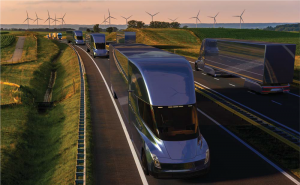 Transitioning to zero-emissions trucks and buses is necessary for both climate stability and to protect communities from air pollution. With nearly 23 million diesel-fueled medium and heavy duty trucks and buses operating on roads today in the U.S., moving to zero-emissions technology will result in significant investments in manufacturing, infrastructure, operations and maintenance training, research and development and midlife vehicle businesses.
Transitioning to zero-emissions trucks and buses is necessary for both climate stability and to protect communities from air pollution. With nearly 23 million diesel-fueled medium and heavy duty trucks and buses operating on roads today in the U.S., moving to zero-emissions technology will result in significant investments in manufacturing, infrastructure, operations and maintenance training, research and development and midlife vehicle businesses.
According to a new analysis conducted by EDF and the consulting firm PwC, a significant amount of investments in the electric truck and bus supply chain has already taken place – yielding a strong and growing domestic supply chain for zero-emissions medium- and heavy-duty vehicles. Amidst the findings by EDF and PwC, four indicators stand out most:
1. The market is geographically diverse – touching nearly all corners of the U.S. economy
According to the study, 375 discrete companies were found to be involved in the zero-emissions truck and bus supply chain – operating in over 1,000 business locations, and present in 44 out of 50 states. Further, at least 20 states have 10 or more company locations involved in the zero-emissions supply chain. These businesses include both new and existing locations, and many that are expanding or modifying their operations to provide zero-emissions equipment.
2. $42 billion and counting in announced corporate investments
Based on a review of public corporate statements and filings, and industry analyses, EDF and PwC found U.S.-based corporate investments in zero-emissions technology totaling over $42 billion since Tesla first announced its battery gigafactory 2014. Additionally, according to the analysis, at least 22 states have been home to over $100 million in announced corporate investments.
3. Investments in zero-emissions trucks and buses support vast numbers of workers, mostly in manufacturing and infrastructure
While investments in zero-emissions technology certainly presents an opportunity for companies to make money, these investments also create and supports jobs. According to EDF and PwC, nearly 336,000 workers are located at company locations across the U.S., with Michigan, California and Texas having the most. There are also at least 8 states with businesses in the supply chain employing over 10,000 people, and 35 states with over 1,000 workers at these businesses. Of the 336,000 workers, over 80% were located at companies involved in the manufacturing part of the supply chain.
4. Companies in the zero-emissions supply chain are present in over half of the U.S. Congressional Districts, demonstrating the broad value of additional support for the sector
One of the major needs for continued growth in the zero-emissions vehicle sector is the establishment of durable state and federal public policy signals that promote additional corporate investment, make it easier to buy and operate the vehicles, and ensure sufficient infrastructure can support rapid and vast deployment. According to the analysis, supply chain businesses were found in 285 of the U.S. Congressional Districts, with districts in California and Michigan leading the way. Additionally, 11 Congressional districts were found to have been home to over $1 billion in announced investments across a wide array of states.
These four factors indicate a strong and growing market for zero-emissions trucks and buses. While many other indicators can be pulled from the EDF and PwC report, the information should also be paired with recent analyses demonstrating a rapid increase in vehicle model availability and manufacturer commitments. When combined, the data and facts clearly demonstrate that a transition to zero-emissions trucks and buses presents a compelling need and opportunity for communities and companies across the U.S.












2 Comments
Thanks for reading this post! My colleagues and I at EDF were excited to work with the firm PwC on this study – and even more excited about the findings. The businesses in the study are both old and new, large and small, located across the US. Please check out the embedded slide deck at the link in the blog to dig deeper into the results of what was found.
It was great to see someone write on this topic. Thanks for sharing your thoughts.